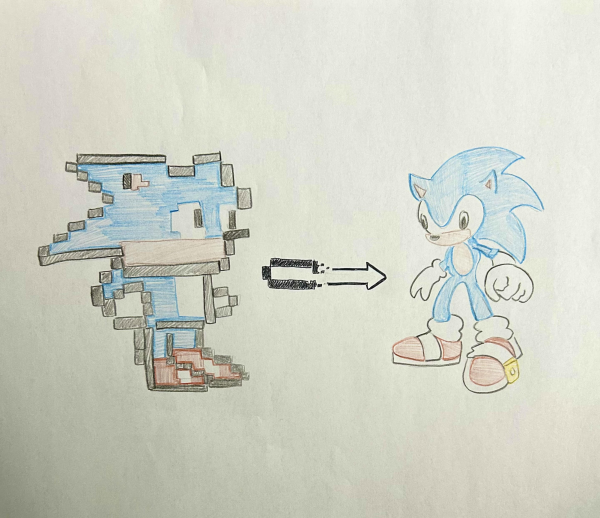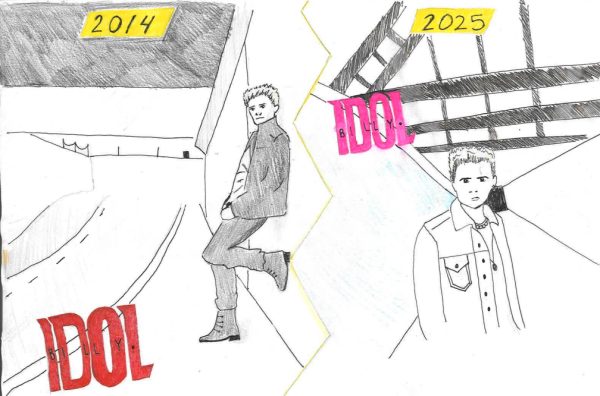Golden Globe nominated film bears concerns over ableism

Sia’s newest project, “Music”, was up for a Golden Globe, despite the blatent ableism the movie displayed.
When my sister was eight years old she sang “Chandelier” by Sia at the top of her lungs with my mother and me. Over and over again, the song would play throughout our small apartment. My sister saw herself in Sia’s video for “Chandelier” — a blonde girl running around and dancing to the music.
This video in particular has muted tones of color, nothing super bright or flashing. About one out of four autistic people have epilepsy, meaning that three of us could watch that video with no risk. Flashing colors, whether or not you have epilepsy, can cause discomfort and anxiety for autistic people. Sia’s new movie, “Music,” which she co-wrote, co-produced and directed, has strobing lights and flashing colors and is meant to be a love letter to autistic people, but frustratingly, it is made completely inaccessible to its intended audience.
Setting the scene, Music is the name of the main character of this film played by Maddie Ziegler. The character is a teenage autistic girl who is nonverbal. People with Nonverbal Autism have a difficult time communicating, sometimes unable to say anything at all. In the movie, Music is shown using an Augmented and Alternative Communication (AAC) device to communicate, a tool given to her by a neurotypical character. The AAC is shown in the movie only shows the options of “Yes” and “No,” while in reality, the devices offer varied responses. These more complicated devices are called Speech Generating Devices (SGD) that can take advantage of head tracking, eye gaze, single and multiple switch control, and joystick and alternate mouse control.
According to the Independent, “13-year-old Naoki Higashida – an autistic Japanese boy with limited verbal skills – wrote his bestselling 2013 memoir ‘The Reason I Jump’ using an alphabet grid. This writing method allowed Higashida to express a rich, self-aware interior life, which he said was often underestimated.”
These AAC devices enable people to be able to express themselves in a complicated way that they weren’t able to before. Higashida has now published 15 books, essays, fairy tales, poems, and illustrated books. Everyone’s voice matters, and it is important to uplift those whose communication skills don’t fit into what society deems acceptable. This lack of nuance is yet another example of the film’s abundant failures.
When I was younger, I had a hard time speaking at all, and my parents were concerned as their almost 5-year-old could barely speak. My little sister still has trouble speaking, and I also stutter over my words even now. No one can “fix” autism but given the tools, autistic people can communicate and function in a society that wasn’t built for us.
Actress Maddie Ziegler is not a nonverbal autistic person; in fact, she is not autistic at all. The problems don’t stop there. She was 14 when this was filmed and the opening scene shows her putting on clothes, which already makes it an uncomfortable start. This opening scene adds nothing to the overall story and could have easily been taken out or changed. When critics and the autistic community pointed out that it is problematic to have a non-autistic person play an autistic person, “Nothing about us without us,” is what Sia had to say.
“I realized it isn’t ableism — I mean it is ableism I guess as well, it’s actually nepotism cause I can’t do a project without her [Maddie Ziegler],” Sia said in an interview with The Project.
Due to this backlash and more, Sia has now deactivated her Twitter after a scene from “Music” was leaked. That scene was from about 20 minutes into the movie when Music has a breakdown over her schedule being changed. These breakdowns occur when an autistic person is overstimulated or in an overwhelming circumstance. An important distinction to make between an autistic meltdown and a temper tantrum is that a child having a temper tantrum is trying to gain something out of the situation, whereas an autistic meltdown is someone not in control at all.
“Common signs of a meltdown include hand flapping, head hitting, kicking, pacing, rocking, hyperventilating, being unable to communicate and completely withdrawing into myself. All of these behaviors are methods of coping,” PhD researcher Sarinah O’Donoghue said to BBC news.
In the movie, Music is shown to be having a breakdown — breaking things and hitting herself, which is an accurate depiction of some meltdowns.
Sia partnered with Autism Speaks to conduct her background research for the film, according to Entertainment Weekly. Sia clearly did not think about who she was partnering with as Autism Speaks has a long history of not showing respect for autistic people, going as far as to say that marriage with autistic people is doomed to fail.
“I’m going to crush you now and make you feel safe,” says Ebo, Music’s neighbor played by Leslie Odom Jr.
“You’re not hurting her, are you?” asks Zu, Music’s sister played by Kate Hudson
“I am not. I am crushing her with my love.”
This practice of crushing an autistic person until they calm down is not healthy and should not be shown in a light where this is okay or helpful. It is damaging and just wrong.
Where this crushing probably comes from is Deep Pressure Stimulation (DPS). DPS is described as gentle hugs or firm squeezing to help reduce the stress of a child. What is shown in the movie is a neurotypical character practically tackling Music and telling her “it’s okay.”
“I remember having a breakdown, and I remember being stressed and not wanting to be touched.” LuLu Alloy (6), a student at Columbia Academy said. “I don’t think yelling at her or tackling her was the right thing to do,”
In fact, some autistic people get tactile defensiveness where they don’t want to be touched at all. There are better tools and ways to go about handling an autistic meltdown. One of the tools that would have been just as easy to show in the film other than tackling someone — something shown more than once in the film — is a weighted blanket. Purposefully weighed down, it can give a sense of comfort to the person under it, simulating a hug without a person hugging you.
Another nuance integral to Autism is that it is a spectrum. Not all autistic people are nonverbal or get tactile defensiveness. “Music” shows a stereotype of an autistic person rather than a real autistic person. Music really is just a token autistic person for the sake of an autistic person. She is a static character that doesn’t undergo any change within the film whereas the characters around her evolve because of her. She is used as a plot tool to further other characters, despite supposedly being the main character.
With all of this said, it is mind-boggling that this movie was nominated for not one but two Golden Globe nominations. This is why many petitions have been set up and a petition created to rescind “Music”’s Golden Globe nomination has over 130,000 signatures.
Autistic people in media are shown as mostly very dumb or very smart, which doesn’t truly encompass or actually show Autism. An actually good show showing autism is “Love on the Spectrum” by ABC Australia, a reality show that follows a group of singles with autism navigating the world of dating. And yes, Sheldon from “The Big Bang Theory” is autistic, but he falls into a stereotype that is now being overdone. Although Sheldon’s portrayal is not entirely inaccurate, this stereotype only represents about 10 percent of individuals on the autism spectrum.
To actually achieve a good message and to show what autism really is you need to show the spectrum in a healthy way that isn’t damaging, and the movie “Music” did not do that.
Nothing about us without us.

Sol Schindler is a senior at CHHS and is the A&E Editor and lead cartoonist of The Heights Herald. He is in the National Honors Society, Student Council,...







